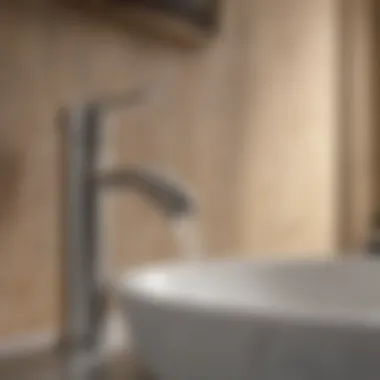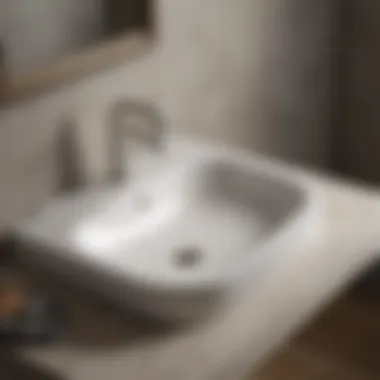Understanding Drop-In Bathroom Sinks: Design & Benefits


Intro
Renovating a bathroom can be an intricate task but selecting the right sink is critical for both aesthetics and functionality. Among various options, the drop-in bathroom sink with a single hole installation offers a balance of simplicity and elegance. Unlike other sink types, the drop-in sink rests on a countertop. This design choice does more than enhance the appearance; it also enables ease of installation, making it appealing for many homeowners.
With a single hole, these sinks simplify the process of fitting a faucet, as they require only one cut-out. This aspect reduces clutter and can contribute to a clean look, enhancing the overall vision of your bathroom. In this article, we will explore everything from planning through to enjoying the benefits of your new drop-in bathroom sink.
Materials:
Before beginning any DIY project, gathering the necessary materials is key. For installing a drop-in bathroom sink, you will need the following:
- Drop-in Sink: Ensure it’s made from a suitable material such as porcelain or stainless steel, and verify its dimensions to fit your countertop (typically ranges 20 to 30 inches long).
- Faucet: Choose a faucet compatible with the single hole. Standard sizes often include 1-3/8 to 1-1/2 inches for the base.
- Plumbing Supply Kit: This typically includes water supply lines and connectors. Average lengths are about 1.5 to 2 feet.
- Silicone Caulk: A high-quality silicone sealant for secure placement, often requiring about 10-20 fluid ounces.
- Mounting Clips: These help secure the sink to the countertop. Make sure you have about four clips for a firm hold.
- P-Trap: A necessary part for your new drain setup. Length varies according to the reach from your sink to the main drain line.
- Rag or Towel: Useful for clean-up during installation.
DIY Steps:
Step 1: Measure the Space
Before purchasing materials, measure the space available for the sink. Make sure to note the existing plumbing lines to align the new installation properly.
Step 2: Select Your Sink and Faucet
Based on your measurements, choose a sink that fits snugly in the intended area. Ensure the faucet matches the sink design and functionality.
Step 3: Prepare the Countertop
If there is an existing sink, remove it carefully. Clean the countertop area to remove all debris and grease, ensuring a secure adhesion for your new sink.
Step 4: Apply Silicone Caulk
With a caulk gun, apply a bead of silicone around the edge of the countertop where the sink will sit. This will form a watertight seal.
Step 5: Place the Sink
Gently set the sink into position, ensuring it sits evenly in the cutout. Press down firmly to create a secure fit.
Step 6: Secure the Sink
Attach the mounting clips under the sink, tightening them to ensure it does not shift or slide. Don't overtighten, as this can crack the sink.
Step 7: Install the Faucet
Following the manufacturer instructions, install the faucet in the provided hole. Check for proper alignment and secure it tightly.
Step 8: Connect Plumbing
Attach the P-trap to your sink's drain outlet and connect to the main drain line. Then connect the water supply lines to their respective valves.
Step 9: Test Your Installation
Turn on the water supply and check for any leaks around the faucet and drain. Make adjustments as necessary.
Step 10: Finishing Touches
Once everything is secure and tested, clean any excess caulk around the edges for a polished look. Also, give your sink a good wash to remove installation grime.
Technical Aspects:
Installing a drop-in sink demands certain tools and timing considerations. Here’s a quick overview of tools you will need:
- Tools Required:
- Timing Specifications: Expect to spend 2 to 4 hours on a complete installation from start to finish, depending on your skill level and the complexity of plumbing existing.
- Adjustable Wrench
- Screwdriver
- Caulk Gun
- Pipe Cutter
- Drill
Critical Techniques:
- During installation, ensure faucets and components line up properly to avoid misalignment.
- Call for help: Sometimes having an extra pair of hands can make positioning and securing the sink easier.
Troubleshooting Tips:
- Leak Around the Drain: Ensure the P-trap connection is secure and that all rubber washer seals are in place.
- Sink Wobbles: If uneven, adjust mounting clips or add more silicone under the sink for further stabilization.
Preamble to Drop-In Bathroom Sinks
The drop-in bathroom sink with a single hole installation is an increasingly popular choice for both remodeling and new constructions. Its design simplicity offers a blend of aesthetic appeal and functional efficiency, catering to the needs of modern homeowners. This section aims to explore the features that make drop-in sinks a valuable addition to any bathroom.


A drop-in sink, as the name suggests, drops into a prepared opening in the countertop. This feature confers a measure of convenience during installation. Additionally, it provides a seamless appearance with minimal visible edges, which can enhance the overall look of the space. Homeowners appreciate the versatility these sinks offer. They come in various styles and materials, allowing for personalized touches in bathroom décor.
Several factors contribute to the choice of drop-in sinks. For instance, their ease of installation can save time and expenses compared to more complex options. An understanding of these benefits is crucial for homeowners looking to upgrade their bathroom features without unnecessary complications.
Furthermore, the design of drop-in sinks aligns with contemporary décor trends. Their single hole design allows for sleek, minimalist faucet options, which can reduce visual clutter in the bathroom. By choosing a drop-in sink, homeowners not only enhance their bathroom's functionality but also invest in an enduring design that can adapt to future aesthetic changes.
Definition of Drop-In Sinks
A drop-in sink is a type of sink that is set into a countertop from above. It features a lip that rests securely on the counter, which helps it maintain stability and gives it a finished look. Drop-in sinks are available in various materials including porcelain and stainless steel. Each material brings its unique advantages and aesthetic qualities to the bathroom environment.
The installation method for drop-in sinks is straightforward—cutting the countertop to fit the sink, applying sealant around the edges, and dropping the sink into place. This ease makes them a preferred choice for do-it-yourself home renovation projects.
Overview of Single Hole Styles
Single hole sinks offer simplicity in both installation and faucet selection. Most single hole faucets come with a streamlined design, requiring only one mounting point. This can significantly reduce the effort needed when selecting fixtures. Available in various finishes and styles, these faucets can easily complement the surrounding bathroom decor.
The single hole format also allows for an uncluttered visual presentation. This layout is especially beneficial for bathrooms with limited space or minimalist design goals. Homeowners may choose from a range of additional accessories to enhance functionality, such as soap dispensers or sink-mounted sprayers.
In summary, understanding the drop-in bathroom sink’s single hole style can empower homeowners to make informed choices as they plan their renovation projects.
Design Features of Drop-In Sinks
Design features play a pivotal role in the overall functionality and aesthetic appeal of drop-in bathroom sinks. Understanding these elements can significantly influence the decision-making process for homeowners during a bathroom renovation. Each design component contributes not just to the visual style but also enhances the user experience and practicality.
Materials Used in Construction
Porcelain
Porcelain is a traditional choice for bathroom sinks. Its smooth surface offers ease of cleaning, which is vital for maintaining hygiene in a bathroom. A key characteristic of porcelain is its inherent ability to resist stains and scratches, making it a beneficial option. While porcelain is visually appealing, it can be prone to chipping if not handled correctly. Therefore, homeowners should weigh its aesthetic advantages against the potential for damage.
Stainless Steel
Stainless steel is known for its durability and modern appearance. It is robust and resistant to rust, making it a practical choice for bathroom sinks. Homeowners favor stainless steel because it works well with many décor styles. However, it can show water spots and scratches over time, which requires regular cleaning to maintain its look. Overall, its strength and versatility make it a popular choice.
Composite
Composite sinks combine materials such as stone, acrylic, and resin, providing a mix of durability and aesthetic options. The key feature of composite is its ability to mimic the look of granite or other natural stones without the associated weight or cost. This makes it a favorable choice for those looking for beauty minus the fuss. One disadvantage is that it can be sensitive to heat, which requires caution during use.
Glass
Glass is becoming more popular for bathroom sinks due to its elegant style. A significant benefit of glass is its unique ability to match various design concepts while being easy to clean. Additionally, glass can be tinted or frosted to fit specific aesthetics. However, glass can be fragile and may not be suitable for high-traffic bathrooms. Thus, while it offers a sophisticated look, durability may be a concern for some homeowners.
Shape and Size Considerations
Standard Sizes
Standard sizes are essential for ensuring compatibility with existing cabinetry and plumbing fixtures. They provide a straightforward solution for many homeowners, facilitating easier installation and replacement. A noteworthy aspect of standard sizes is that they tend to be widely available, creating significant cost efficiency. However, they may not fit every bathroom layout, limiting some design possibilities.
Custom Options
Custom options allow homeowners to select sinks that fit their unique spaces and styles. Offering a personalized approach, custom sinks can adapt to specific measurements and design features. This flexibility makes them a beneficial choice for intricate bathroom layouts. However, the downside is often the increased cost and the requirement for longer lead times during production, which some might find inconvenient.
Space Requirements
Space requirements must be carefully measured to ensure a suitable fit for any sink chosen. A good understanding of the available space can prevent over-crowding and enhance functionality. Key characteristics of space considerations include ensuring there is enough clearance for faucets and users. Neglecting this aspect can lead to poor usability and cramped bathroom conditions, which might adversely affect daily routines.
Advantages of Single Hole Drop-In Sinks
Choosing a drop-in bathroom sink with a single hole installation offers significant advantages, making them a popular choice among homeowners. This section explores key benefits including aesthetic appeal, ease of installation, and low maintenance requirements.
Aesthetic Appeal
The design of a drop-in sink can greatly enhance the overall look of a bathroom. Single hole sinks have a streamlined appearance, as they typically feature a minimalist structure. This visibility means the sink becomes a focal point in the room.
Color and Material Choices: These sinks come in various finishes, such as porcelain, stainless steel, and glass. This wide array allows homeowners to coordinate their sink with existing decor. The simplicity also complements various design styles, from modern to traditional.
One can achieve a clean, uncluttered space using a single hole design. Everything is in one area, avoiding the mess of multiple holes and faucets. Ultimately, this adds a sophisticated touch to the bathroom.
Ease of Installation
Single hole drop-in sinks are notably straightforward to install, which can save time and effort. Many homeowners opt for DIY installations simply because of this ease.
Step-by-Step Process:
- Gather necessary tools: a wrench, plumber’s putty, and a caulk gun are essential.
- Remove the old sink if replacing one.
- Fit the new sink into the countertop cutout.
- Secure the sink with mounting clips and seal properly.


The installation does not require complicated plumbing work, making it accessible for those who are not professionals. A single hole means fewer complications during setup, thus reducing the likelihood of errors.
Maintenance and Cleaning
Another significant advantage is the ease of maintenance. Single hole drop-in sinks often present fewer areas for grime and stains to accumulate.
Simple Cleaning:
- The smooth surface common in materials used, such as glass or stainless steel, makes wiping down easy.
- With only one hole for faucet installation, there’s less risk of water accumulating in crevices.
Regular cleaning does not involve elaborate procedures. A gentle cleaner and cloth can keep the surface shiny and new.
"Opting for a single hole drop-in sink streamlines both the installation process and daily care, making them an excellent investment for any bathroom renovation."
The combination of aesthetic appeal, ease of installation, and low maintenance needs makes single hole drop-in sinks an attractive choice for homeowners. With these factors combined, they provide an optimal balance of form and function.
Installation Process for Drop-In Sinks
The installation process for drop-in sinks is a critical aspect that can significantly affect both functionality and aesthetics of the bathroom. A well-installed sink provides seamless integration with countertops, ensuring durability and ease of use. This section delve into the steps needed to properly install a drop-in sink, focusing on preparing for installation, carrying out the procedure, and addressing potential pitfalls.
Preparation Before Installation
Gathering Tools
Gathering the right tools is fundamental for a successful sink installation. The primary tools needed include a wrench, screwdriver, pliers, a putty knife, and a level. Each of these tools serves a specific purpose that contributes to the installation's effectiveness. For instance, wrenches are crucial for tightening nuts and fittings, while screwdrivers help in securing the sink to the countertop. Ensuring that all these tools are available beforehand minimizes delays and frustrations during the installation. Additionally, it is vital to check that the tools are in good condition to avoid issues during the process. Having high-quality tools can lead to a smoother installation, reducing the risk of damage to the sink or countertop.
Choosing the Right Sink
Choosing the right sink is also a major step in preparation. This decision impacts not only the style of your bathroom but also its functionality. Drop-in sinks come in various styles, sizes, and materials, so take time to research the available options. If you have limited space, a smaller sink model may be beneficial, while a larger sink could enhance utility if space allows. The aesthetic appeal of the sink should harmonize with your overall bathroom design, which is paramount for both comfort and enjoyment. Therefore, consider factors like color, shape, and finish when selecting the sink. Each of these elements plays a role in how fit and appropriate the sink will look once installed.
Step-by-Step Installation Guide
Removing Old Sink
The process of removing the old sink is essential for making room for the new installation. First, turn off the water supply to prevent any spills during the removal process. Once the water supply is off, disconnect the plumbing from the old sink. This involves unscrewing the drain and any attached water lines, often requiring pliers and a wrench. Removing the old sink carefully minimizes damage to the surrounding area. Ensure all remnants of old caulk are cleaned from the countertop to prepare the surface for the new sink. This step is important because it ensures a proper seal when the new sink is installed.
Fitting the New Sink
Fitting the new sink involves positioning it into the cutout space in the countertop. Ensure all plumbing connections line up correctly before securing it. Check that the sink sits evenly and is level. A level sink is vital for ensuring proper drainage and functionality. Once you have confirmed correct placement, it is important to apply a bead of silicone caulk around the edge of the sink cutout to create a waterproof seal. This step can prevent water from seeping underneath the sink and causing damage.
Sealing and Finishing Touches
Sealing and finishing touches finalize the installation process. After fitting the sink and securing it, reattach the plumbing and turn the water supply back on. It is essential to check for leaks. Any leaks should be addressed immediately to avoid further complications. Once everything is functioning correctly, clean any excess caulk and debris from the area for a polished look. A neat finish enhances the overall appearance of the installation, making it look professional and seamless.
Common Installation Mistakes
When installing drop-in sinks, certain mistakes can be common. Not removing old caulk completely can lead to problems with sealing and may cause water damage. Additionally, failing to check that the sink is level can result in poor drainage, leading to water pooling or spillage. Finally, not properly tightening connections may result in leaks, leading to more extensive repairs down the line. Being aware of these errors can help ensure a smoother installation process.
Plumbing Considerations
In the realm of drop-in bathroom sinks, plumbing considerations constitute a vital component of both the installation and long-term usability of the sink. Understanding the nuances of faucet requirements, drainage system compatibility, and water supply connections can affect not just the appearance, but also the functionality of the sink space.
Understanding Faucet Requirements
When selecting a drop-in sink with a single hole, knowing the faucet requirements is essential. A single hole sink makes it necessary to choose a faucet specifically designed for that configuration. This means considering factors like the faucet's height, reach, and type of handle. For instance, a tall faucet can provide ample clearance for filling larger containers, while a low profile design might be more appropriate for limited spaces.
It's also important to assess the water flow rate and spout aeration. A well-chosen faucet will enhance the sink's performance and reduce water waste. For those interested in eco-friendly choices, selecting WaterSense labeled faucets is advisable as they meet EPA standards for water efficiency.
Drainage System Compatibility
The drainage system of your bathroom must align with the sink's requirements to ensure proper function. Drop-in sinks typically connect to a P-trap, which prevents sewer gases from entering the home. When installing, ensure that the drain size matches your existing plumbing. Most drop-in sinks use a standard 1.25-inch or 1.5-inch drain size.
If your current plumbing is older, it may not align with newer products. In such cases, you might have to update the plumbing to ensure compatibility. Remember to check for any blockages or damages in the existing drainage system before installation to avoid issues later.
Water Supply Connections
Connecting the water supply is another critical aspect when dealing with drop-in sinks. Most faucet systems require both hot and cold water supply lines. Make sure that the connections are secure to prevent leaks and ensure consistent water flow.
During installation, keep in mind the ideal water pressure. If the pressure is too high, it can lead to leaks; conversely, low pressure may affect the faucet's performance. If necessary, install pressure regulators to balance the flow.
Ensuring that all plumbing connections — faucet, drainage, and supply — are compatible is key to preventing issues down the line and enjoying a functional sink for years to come.
Trends in Drop-In Bathroom Sink Design
Understanding the trends in drop-in bathroom sink design is crucial for homeowners who seek both functionality and style. Selecting a sink is no longer a mere afterthought; it embodies the overall ambiance of the bathroom. Homeowners are increasingly aware of their choices, ensuring that what they install meets both practical needs and aesthetic preferences. Trends dictate not just the appearance but also the sustainability and durability of the products chosen.


The current landscape indicates a shift toward minimalism and eco-friendliness, with designs reflecting broader cultural movements. These trends have implications for how homeowners think about their renovations. By taking note of these aspects when designing or updating their bathrooms, homeowners can achieve a modern look while being conscious of their environmental footprint.
Minimalist Aesthetics
Minimalist aesthetics emphasize simplicity and clean lines, making it a preferred choice for contemporary bathrooms. This trend focuses on eliminating clutter and enhancing open spaces, favoring forms that are functional yet visually serene. In the context of drop-in sinks, minimalist designs often feature sleek surfaces and straightforward shapes.
The beauty of this design lies in its versatility. It complements various decor styles, from elegant to rustic, without overwhelming the bathroom's overall theme. Minimalist sinks often come in neutral colors like white, black, or granite finishes, aligning well with a monochromatic color palette.
Key Benefits of Minimalist Sinks:
- Easy to Clean: Fewer crevices and simpler shapes reduce the time required for maintenance.
- Timeless Appeal: A minimalist sink can withstand changing design fads, ensuring long-lasting relevance.
- Effective Space Utilization: These sinks often work best in smaller bathrooms, allowing more open space to breathe.
Considerations for Homeowners:
- Counter Space: Ensure the sink design integrates well with your countertop.
- Additional Design Elements: Consider how fixtures, lighting, and color schemes interact with the sink.
- Budget: Minimalist sinks can range widely in price, so evaluate your options without compromising your vision.
Eco-Friendly Options
As environmental concerns become more prominent, eco-friendly options in bathroom sink designs are gaining traction. These sinks are not only designed to reduce water usage but also take into account sustainable materials and manufacturing processes. Homeowners are looking to align their purchases with their values, making sustainable choices that positively impact the planet.
Eco-friendly drop-in sinks often use materials that are either recycled or sourced responsibly. Common options include bamboo and refined glass, which can add unique textures to the bathroom environment. Moreover, many designs incorporate water-saving faucets or elements that promote efficient usage.
Benefits of Choosing Eco-Friendly Sinks:
- Water Conservation: Many eco-friendly sinks feature designs that minimize water waste.
- Reduced Carbon Footprint: Sustainable materials often mean lower emissions during production.
- Healthier Living Spaces: Products made with fewer chemicals contribute to better indoor air quality.
Points to Keep in Mind:
- Research Brands: Not all materials labeled as eco-friendly are truly sustainable. Look for certifications or third-party verifications.
- Long-Term Costs: While eco-friendly options may have higher upfront costs, the savings from reduced water bills can make them economical over time.
- Aesthetic Integration: Ensure that eco-friendly choices align with the desired style; they can look just as elegant as traditional materials.
By considering these trends, homeowners will find themselves better equipped to face the decision-making process regarding drop-in bathroom sinks. Trends are not just about looks but also about aligning personal values with practical choices.
Costs Associated with Drop-In Sinks
When considering a drop-in bathroom sink with a single hole installation, it is essential to evaluate the associated costs. Understanding these costs helps in making informed decisions, especially during a bathroom renovation. It is not only about the price of the sink itself but also includes various factors that contribute to the overall expenses.
First, the choice of material greatly influences the price range. Different materials come with distinct qualities and durability, which can alter how much one may spend on a sink. For instance, porcelain might be more affordable than stainless steel yet they each offer unique advantages and disadvantages. Therefore, it’s critical to assess materials alongside budget considerations not just for the immediate cost but for long-term value.
Furthermore, installation is a key component of total costs. Professional installation might seem like a safe route, ensuring that everything is done correctly. However, it may also increase the overall budget significantly. Homeowners need to factor in these expenses and consider whether they can take on the installation themselves. This decision often comes down to skill level, tools available, and time constraints.
In summary, understanding the costs associated with drop-in sinks enables homeowners to plan effectively and invest wisely in their bathroom projects. Evaluating materials, labor, and potential hidden costs will lead to a more realistic budget and better outcomes.
Pricing for Different Materials
Different materials used in drop-in sinks can vary widely in price. The common materials include:
- Porcelain: Often the most budget-friendly option. This material is popular for its classic look but can be prone to chipping.
- Stainless Steel: Typically more expensive, stainless steel sinks are durable and resistant to rust but may show water spots more easily.
- Composite: This option combines various materials to offer durability and aesthetic appeal. Prices can be mid-range to high, depending on the blend.
- Glass: Known for a modern touch, glass sinks can be quite pricey. They are delicate and require careful maintenance.
Each material comes with its own set of advantages and disadvantages. The decision should take into account both aesthetic preferences and practical considerations such as maintenance and longevity.
Installation Labor Costs
Installation labor costs can often be overlooked when budgeting for a drop-in sink. Homeowners may experience varying rates based on location, the complexity of the installation, and whether plumbing adjustments are necessary.
The typical cost range for professional installation can be:
- Basic Installation: If the sink is placed in the same position as the old one and involves no major plumbing changes, costs might be lower, about $100 to $200.
- Complex Installations: If plumbing needs substantial modification or if the sink size changes, prices can rise significantly, often reaching $300 to $500 or more.
Investing in professional preparation leads to peace of mind, ensuring that the installation meets local plumbing codes and standards. It may also save money in the long run by preventing potential water damage or sink malfunctions from improper installation.
The End: Making the Right Choice
Choosing the right bathroom sink is a crucial step in any renovation project. The drop-in bathroom sink with a single hole is an appealing option for many homeowners. It offers various advantages, including ease of installation, maintenance efficiency, and aesthetic versatility. When selecting a sink, you need to assess your specific requirements and preferences.
Assessing Your Bathroom Needs
Before deciding on a sink, consider several factors that relate directly to your bathroom. Space availability is paramount. A well-measured sink not only fits your bathroom's layout but also complements the overall design. Think about the style of your bathroom. Is it modern, traditional, or minimalist? The sink’s design should agree with the surrounding aesthetics.
Functional needs also play a significant role. How many people use this bathroom? A larger sink may serve better in a family home, while a smaller unit might suffice in a guest bathroom. Additionally, examine the plumbing setup. Confirm whether your existing plumbing can support the sink you choose, especially if transition to a different material or installation type is desired.
Budget is another important consideration. Drop-in sinks come in a range of prices based on material and design. Allocate funds wisely to avoid overspending while still achieving high quality. In summary, a thorough evaluation of your bathroom needs leads to confident decision-making which ensures satisfaction with your renovation.
Future Trends in Sink Design
The bathroom sink market evolves continuously, with emerging trends that shape design choices. Many consumers now focus on sustainability. Eco-friendly options like recycled materials and water-saving faucets are gaining traction. Homeowners are increasingly interested in the environmental impact of their purchases.
Another emerging trend is the rise of smart technology integrated into sinks. Features like sensor-activated faucets and built-in lighting are becoming more common. These innovations offer added convenience and can enhance the overall functionality of your bathroom.
Designers are also favoring minimalist aesthetics. Clean lines and uncomplicated features resonate with many homeowners. This trend often leads to versatile sinks that can fit various decoration styles without overpowering the space.
Ultimately, understanding these trends aids homeowners in making modern and stylish choices. Incorporating these aspects into your decision-making ensures that your new sink will remain relevant and appealing for years ahead.







